


























Central New York will be experiencing a major transformation in the next few years with the arrival of MICRON and its impact over the next several decades. We have long awaited such opportunities to return to the Central New York region for our children, as they become young adults, to have careers here. Now, that time has come, and educators are working to ensure our youth are ready to meet this opportunity.
From laser surgery to smartphones, the micro-memory chip industry is transforming life on this planet and beyond with capabilities at our fingertips. As pre-k to 12 educators, our responsibility is to graduate students who will succeed in a world that is defined by a rapidly changing, technologically advanced global environment.
First and foremost, our region will need to recognize the importance of a learning ecosystem. It is obvious that MICRON does. A STEM (Science, Technology, Engineering & Mathematics) or STEAM (includes Arts) Ecosystem is inclusive of parents and families, pre-k to 12 schools, higher education institutions, community agencies that provide before/after-school and summer programs (e.g. YMCA) and science centers and museums (e.g. MOST). Collaboratively, they foster an interdependent relationship that ignites a synergy, which fuels the learning of skills, competencies and technologies for success in learning and career pathways.
This type of learning requires partnerships with businesses, community agencies, higher education and STEM-rich institutions for 24-7 learning access, in environments that provide real-life application for problem-solving, collaboration, creativity, communication and innovation.
We must plant the seeds of these career landscapes at the earliest ages and stages of learning in our early childhood programs and elementary schools. At the middle school level, trans-disciplinary learning is critical to developing problem-solving skills, the ability to collaborate and communicate effectively with real-world application of knowledge, skills, competencies and technologies through integrating content areas rather than subjects being taught in isolation.
In February, an eighth-grade team at Pine Grove Middle School launched a projectbased learning module on the design and build of a semiconductor chip manufacturing process model. When the student-led, designed and built model was shared, MICRON executives were so impressed that they provided resources for the team to build a second model to display at the MOST MICRON exhibit this August. This type of exemplary learning model is essential to the design of learning in all middle schools.
Middle school students in Central New York who recently attended one of the three Chip Camps sponsored by MICRON were immersed in similar engaging, interactive learning experiences.
At the high school level, opportunities for Career & Technical Education (CTE) and Early College High School (ECHS) programs are essential for youth becoming futureready. CTE programs in Computer Science and the related construction, service and manufacturing industries that will be buoyed by the infusion of MICRON will be a high priority for every high school.
ESM’s Spartan Academy ECHS, supported by grant funding from the New York State Education Department, provides our students with the opportunity to earn 24-60 college credits and graduate from high school with a diploma and an associate degree in computer science, engineering science or math/science from Onondaga Community College. Students then have continued opportunities for a bachelor’s, master’s and doctoral degree in one of these fields. These types of programs will need to be supported and expanded in high schools for continued growth in this area.
In preparing for the success of all learners, it is essential to create a culture that models and embraces inclusionary principles and practices with an emphasis on the development of relationships that cultivate confidence, an understanding of individual worth and an appreciation of individual differences. Recognizing, valuing and engaging the voices and talents of all of our stakeholders is key to our success.
SyracuseWomanMag.com
contact@ syracusewomanmag.com
PUBLISHER
David Tyler
dtyler@eaglenewsonline.com
DESIGN
Andrea Reeves
PHOTOGRAPHERS
Alice G. Patterson
Chef Eric Rose
David Tyler CONTRIBUTORS
Cheryl Abrams

Janelle Davis
Alyssa Dearborn
Kate Hanzalik
Amisha Kohli
Chef Eric Rose
Frances Sharples
Cover photo by Alice G. Patterson
ADVERTISING SALES
Renée Moonan Linda Jabbour 315.657.7690 315.657.0849
Rmoonan@ eaglenewsonline.com Ljabbour@ eaglenewsonline.com


Unlike any other publication in the Syracuse area, our feature articles address major topics that interest local women. Each issue includes articles on health, fashion, fitness, finance, home matters, dining, lifestyle and personal perspectives, as well as a spotlight on local Syracuse women. Ads are due on the 15th of the month prior to publication. The print magazines will be distributed locally in over 350 locations and will be in your inbox electronically by the middle of every month.
The publication is available free of charge.
CONTACT OUR HOME OFFICE
315.434.8889 | 2501 James Street, Suite 100, Syracuse, NY 13206
The magazine is published 12 times a year by Community Media Group, LLC and Eagle Publications 2501 James St., Suite 100 Syracuse, NY 13206
Copyright © 2023 Community Media Group, LLC. No part of this magazine may be reproduced or republished without the consent of the publishers. Syracuse Woman Magazine is not responsible for unsolicited submissions, manuscripts, photos or artwork. All such submissions become the property of Community Media Group, LLC and will not be returned.
As parents or mentors, we educate our children and loved ones to prepare them for success. Knowledge is power. Armed with knowledge, we can usually face difficult or stressful situations with less anxiety, the appropriate emotion - and more control.
For most people, beginning the divorce process is an especially emotional and frightening time. Like anything else, if you have educated yourself, you will be better prepared and feel less stress, armed with knowledge of what to expect and the tools to get you through the process.
Developing a strong support network and understanding how to prepare for the proceedings can help you to feel more in control.
Here’s a brief overview of the key actions to take when preparing for divorce in New York State:
gatHer FinanciaL PaPers
If you’re considering filing for divorce, it’s vital to begin collecting your financial information as soon as possible. Make copies of at least one year’s worth of bank statements, tax returns, insurance policies, pay stubs, investment statements, deeds, credit card bills, and other financial statements. Store these in a secure location so you can present them to your attorney when the time comes. Having these documents already gathered will help the process move more quickly.
If you haven’t been involved in the finances of your marriage and/or do not have access to some or all of your financial information, your lawyer will have procedures available to get access to financial documents and information through the divorce process. A good place for you to start, if you do not have complete knowledge of your marital finances, is by making a list of the assets and debts that you are aware of, and those that you believe to exist (e.g. bank accounts, retirement accounts, real estate).
set a buDget
You should also set a projected budget. When getting divorced, most families go from a dual-income, single household to separate households each supported by a single income. This division of finances will mean significant life changes for most, even those with a favorable divorce settlement. It is important to take a realistic look at your financial situation and prepare yourself for any changes that may be in your future and to know what your financial needs will be after the divorce.
KnoW WHat to exPect iF you are serveD WitH a comPLaint For Divorce
If you’re served with divorce papers in New York State, you have 20 days to file an answer. If you do not respond within 20 days, your spouse may be able to obtain a default judgment and proceed with the divorce without your input. That means they will get to decide the terms of the

divorce, possibly leaving you in a very difficult situation. So, once you have the initial divorce papers, find an attorney and respond as soon as possible.

Having an experienced, knowledgeable attorney right from the start is essential. Your attorney can educate you on the divorce process, help you to understand your rights and obligations, and lessen your fears. Be sure to choose an attorney with whom you feel comfortable and can trust. After all, you will be spending considerable time with this person, sharing some of the most personal details of your life. In addition to legal counsel, building a strong support team can be crucial including counselors, financial professionals, estate planning attorneys, real estate agents, HR/benefit administrators and of course family and friends.
Everyone knows someone that is divorced. Many of us are familiar with horror stories of the divorce process and potential outcomes. It is important for you to know that not all divorces involve long and expensive court battles. In fact, in some situations divorcing parties do not have to go to court at all.
There are options for divorce that allow you to stay out of court and focus on preserving your family and protecting your children and your finances. These options include uncontested divorce, collaborative divorce and mediation. If you and your spouse can agree on any of these three alternatives to a court-based divorce, your divorce will likely proceed from start to finish more quickly and easily and with less expense.
The divorce attorneys at WCP Law have extensive experience in helping clients through this challenging time with compassion, understanding and efficiency. We are prepared to educate you so that you are armed with knowledge and can see a clear path forward. The attorneys at WCP Law focus their practice on divorce mediation as well as uncontested, collaborative and court-based divorce. If you’re considering divorce or have been served with divorce papers and live in central or western New York, call the divorce attorneys at WCP Law today to set up a consultation. Clients tell us that after just one meeting, they experience reduced anxiety and a fresh perspective on the divorce process and their future. WCPlaw.com - Your Family is Our Business. WCP

Lisa DiPoala Haber, Esq. is a divorce and family law attorney and partner with the firm of WCP Law in Syracuse, NY.

When Dr. Tina Chee started her practice with Up Design Primary Care, she wanted to enhance the collaborative journey between the patient and the physician. Building her business with a philosophy focusing on better health through lifestyle habits, Dr. Chee aims to help people live healthier lives.

“What I’m interested in is helping people live their healthiest, and so a lot of the time in the conventional insurance-based practice, there’s just not a lot of time that patients and doctors can spend together to talk about changes they can make and really get behind the reasons for their symptoms,” she said when asked about why she started her practice. “And so, I was looking for a model of care that
would allow me to spend enough time with my patients to give me better autonomy to practice. So, that led me to finding out about this model called direct primary care.”

Unlike most healthcare practices, Dr. Chee’s practice uses a direct primary care model in which patients pay a subscription price. Patients then have access to many services offered within the practice.
“That includes most of my services,” she said. “So whether someone needs a physical, sick visit, on-going management, regular touch-bases, it includes all of that as well as the more guaranteed appointment access.
This model allows her to spend more time with each patient and appointments generally take
30 minutes to an hour, depending on people’s needs. Patients also have the ability to email or text her directly, rather than going through several different people to get a response from their doctor.
“It’s kind of going back to the way things were before this whole focus on volume and just getting as many patients through the door as possible,” she said.
But the direct primary care model is not just a business model. For Dr. Chee, the model is a cornerstone of how she can better connect with her patients.

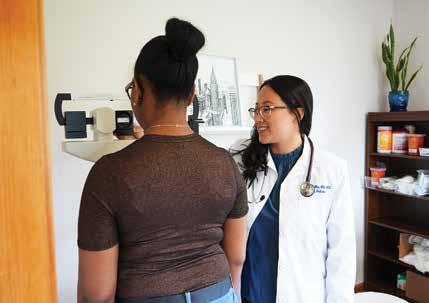
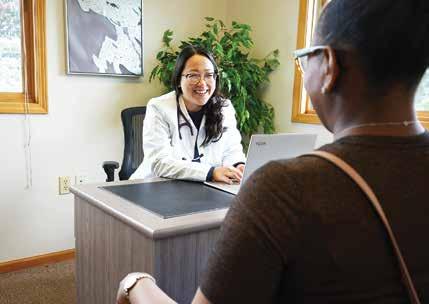
“I see myself as a visitor in the patient’s life. Everyone has a certain preference, things that they’ve seen through life. So I’m more of the mindset that I’m there to help and can [help] think through their preferences and the risks and benefits of certain choices with medications and achieving their health goals,” she said. “One of the first questions I ask people is ‘what are your health goals?’ because I really like to be able to help people reverse certain things that are related to causing their disease. There’s high blood pressure, diabetes, issues related to higher weight going on and oftentimes you really need some help, not just the doctor telling you what to do, but helping you reach specific goals, making small changes over time to reach those big goals.”
The direct care model can also be beneficial to the healthcare provider, allowing doctors to provide more focused service to a smaller number of patients and avoid burnout.
“I think that there is a lot of challenges related to physician burnout and a lot of that is related to the way that the system is structured,” she explained. “It’s really back to the relationship between doctors and patients and that’s what people are seeking: to have a good relationship with their doctor, to be able to talk to them and address their concerns. The impact is with this direct primary care model, what I see, is part of the answer. Maybe not the whole answer, but part of the answer.”
One of Dr. Chee’s popular offerings at her practice is her weight loss program. The program, which is planning to start a new session in September, is a six-month program that combines one-on-one appointments with small group sessions with other people enrolled in the program.
“It’s a combination of the medical evaluation, so one-on-one visits with me,” she explained, “and we’ll go through your medical history, if there are certain weight loss medications that are a fit for you. And also an every-other-week group session where it’s a small group of a few people
and we go through topics that are related to health. [It’s] both education and setting goals together and accountability. So it’s kind of everything you need to have a natural process to lose weight as well as adjusting to healthier lifestyles.”
When asked about how the WBOC has helped her run her business, she said how being around other entrepreneurial-minded women has helped to inspire and motivate her.
“I think a lot of times when you are on this journey of building a business, it’s helpful to have a community to talk through some of the challenges and to have support and to just have community,” she said. “Because, you know, finding your tribe is really important in terms of just having that support network. That’s been one of them. I think that just the women that I’ve met who are building their own dreams as well is always inspirational.”
But for Dr. Chee, her practice is not just a business, it’s her way of helping people live a better, healthier life.
“At the end of the day, talking to my patients and helping them improve their health. I think it’s super rewarding to help people reverse their diabetes, to help them get to a healthier weight so that they can start feeling better, not just because of the weight number,” she said. “There’s so many symptoms related to weight, like acid reflux, pain, less mobility, mood symptoms and to help them just feel better.” SWM
To learn more about Up Design Primary Care, visitupdesignprimarycare.com.
Most financial plans have common components, such as wealth accumulation planning, and others do not apply to every situation. Not every family has children so maybe college education planning does not apply. One aspect of planning that most people do not automatically anticipate is the area of special needs planning. It is a unique and complex area of wealth management to navigate because, unlike other parts of practice, special need planning presents a continuum that is fluid and often changes throughout the course of a lifetime.
If you have a loved one with special needs, whether it is a physical, intellectual, or developmental disability, often people are not prepared to be facing the challenges that they have found thrust upon them. In some cases, families are aware of a prenatal diagnosis, such as Down Syndrome, and can give thoughts to the needs of their child ahead of their arrival. Other disabilities are invisible, such as autism, and a diagnosis presents sometime after birth. In either scenario of being prepared or not, there are hard realities that families much face when caring for and planning for a person with special needs, and that goes beyond the everyday tasks and medical considerations that present immediately.
Consider this – if a financial advisor told you that navigating the continuum of special needs planning is much like driving and following traffic lights, what would you think? I use this analogy often since as a family, you have to keep moving forward, but there are certain things that you must consider (red). There are some planning items that will come into play along the road and give you cause to slow down (yellow). Then there are planning items you may need to consider down the road, but for now you just keep on driving because they may not come into play at all (green). Although it is a complex topic and area of practice, it is much simpler to compartmentalize when we look at it in those three categories.
Think of the stop light in terms of life stages. Red would be as soon as you learn of your special needs circumstance, yellow as you are raising your child or loved one throughout their growing years, and green for post-secondary education and adulthood. Today this is how many agencies are providing support and services to those with special needs. Life Centered Planning has become a popular term in recent years as the needs of people change depending on their stage of life. Special needs planning from a wealth management perspective can be approached the same way.
So, where do you start? With the must-do’s, and the major topic here for consideration is with your estate plan. It doesn’t matter if you think you have a sizable estate or not, it is critically important for you to have your legal documents in place to protect your disabled loved one. Many younger couples have some savings, maybe a house or some level of insurance coverage in place to protect their families. If you have a child with a disability and do not have the proper estate planning mechanisms in place, it could be catastrophic to that child. Children who have disabilities are only allowed to have limited resources in their name or they can become disqualified for public benefits that they are entitled to or may be at some point in the future. It is critical to work with an estate planning attorney who is well versed in supplemental needs trust planning to make sure your child is protected.
For families with school-age children education planning has also become a must-do since the COVID crisis. The pandemic has presented
tremendous difficulties as many students have not been able to receive therapeutic and interventive services they are entitled to. Having an extensive knowledge of your children's rights under education law is necessary, and you may need to partner with an advocate or attorney who specializes in this area of law. This would be to help ensure that your child's education planning remains on track with their individualized education plan based on the goals tailored to their unique situation.
Along the course of the roadmap there are other planning items that may come into play besides estate or education planning that you will likely hear about or encounter. It is important to note that not all children who have a disability are automatically entitled to public assistance or benefits, and without these benefits it can become a costly proposition to any family who may have to pay out of pocket for care or services. Proper planning can position you for long-term success and partnering with experts to guide you through these life stages, or the traffic light, can help ensure all of your goals are met. SWM
Iris Buczkowski is the founder of Birch Wealth Management (birchwealth.com). She is also a parent of a child with a developmental disability and has personal experience with many components of special needs planning. Original content provided by Iris is for education purposes only and should not be construed as investment advice.


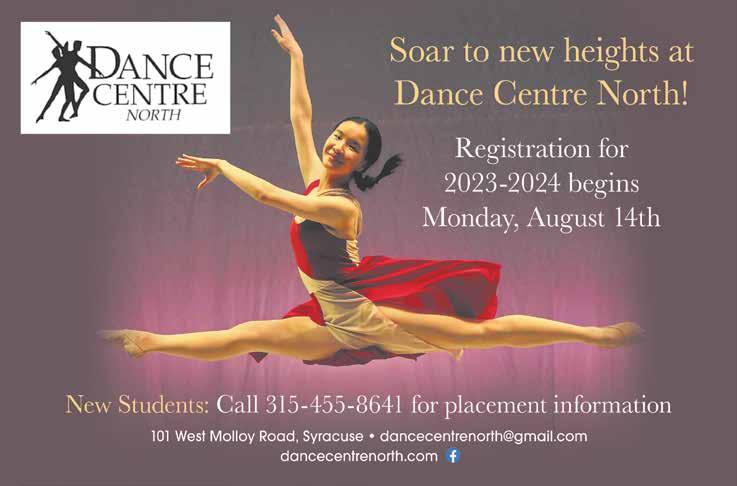

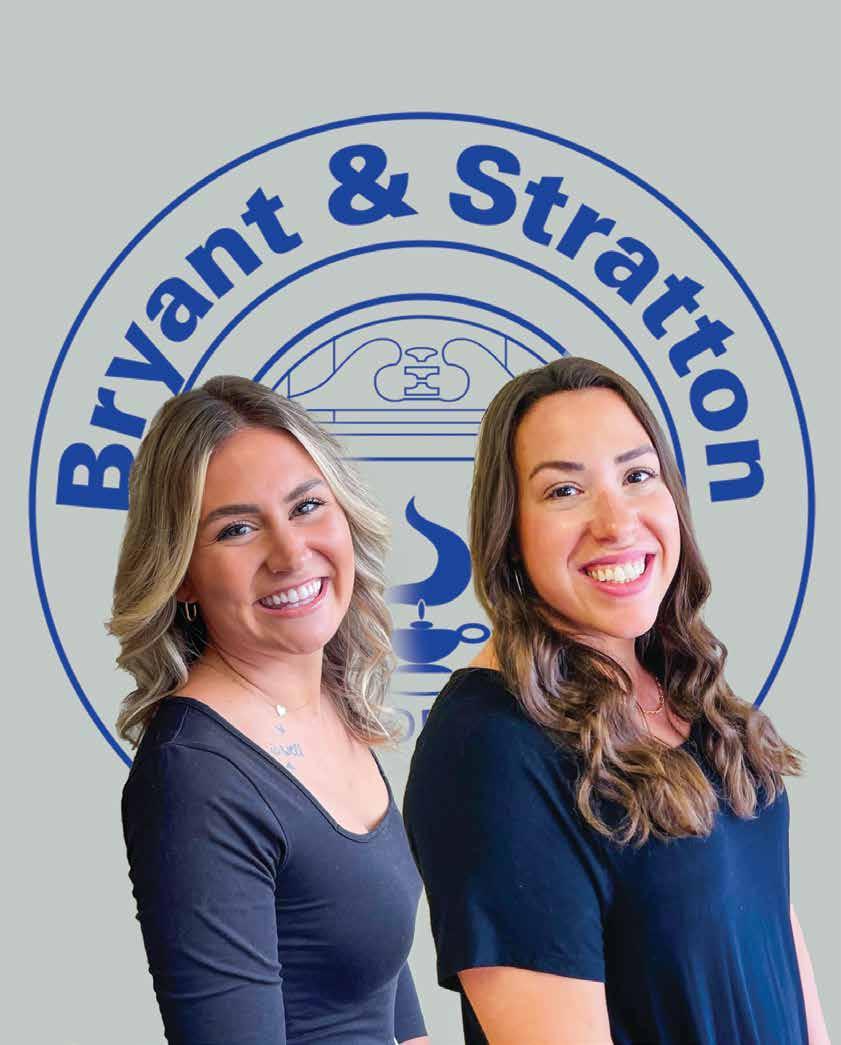
Bryant & Stratton College (B&SC) has been home to Melissa Seltzer and Brooke Laukaitis as students, entry-level employees, and, most recently, campus leaders. Although they both started their journey at B&SC as students, they took unique paths to get there.
Brooke was the salutatorian of her small Christian high school, then went on to graduate from Cayuga Community College before transferring to B&SC as a student athlete playing women’s soccer. Melissa went to a large local high school but was unsure if she wanted to continue her education and earn a degree. After some thought and encouragement, she enrolled in B&SC’s paralegal program.
Both Brooke’s and Melissa’s college experiences changed how they viewed education and their futures.
Brooke was a residential student athlete and enjoyed the individuals that she lived, trained, competed, and studied with. She became a resident assistant mentoring new students, most from outside the United States. As a student, Brooke developed a close relationship with her academic advisor, describing her as “the best I’ve ever known.” She would visit her advisor daily to talk about challenges, triumphs, and future goals. She spent time working in England after completing her bachelor of science, and then she returned to Central New York, where she found herself back at B&SC as an administrative assistant and assistant director of residence life.
Melissa was successful from the start of her B&SC experience. As a dean’s list student, she completed her associate degree and later a bachelor of science, all while continuing to work. She attributes her success to the personalized education she received at B&SC, which was “smaller than my high school.” Melissa said, “People know your name!” After graduation, Melissa began her career as a B&SC admissions representative and was later promoted to senior representative.
“I wanted to help others feel the spark for education that I experienced as a student,” she said. “The students were just like me, and I made it a goal to help them see themselves as college students.”

Brooke and Melissa each left Bryant & Stratton College to work elsewhere for a short time but maintained their connections. Brooke continued to live in housing as a part-time assistant housing director while working full time at a local bank. She then returned to B&SC, accepting the director of residential life position at just 25 years old, supporting international athletes at the college’s Syracuse campus.
Melissa was a remote employee for a well-known private university, but within 10 months was back at B&SC, this time, as associate director of admissions at the Liverpool campus, working primarily with students in the bachelor of science in nursing program.
As new leaders, Melissa and Brooke were faced with the challenge of leading former coworkers. They used their experience to inspire and support colleagues and become the best leaders they could.

Providing support for students is another core value that Brooke and Melissa share. Brooke sees herself as an advocate for students and creates personal connections with each one. “The biggest blessing of this job is to share my experiences with them,” she said.
Melissa is proud to work with students who may have tried other educational routes but ultimately found success at B&SC. “That’s the best part, feeling like you’re making a difference in someone’s life,” Melissa said. As the new school year approaches, Melissa is excited to see how her team will grow, and Brooke is looking forward to watching the dorm students become a family. “I can’t wait to make it an exciting year for them,” Brooke said.
Mary Hawkins, campus director for Bryant & Stratton College’s Syracuse campus, echoed their excitement. “It’s a great joy to see new students on campus, watch students and staff flourish, and then end the year with a moving commencement ceremony,” she said. “Brooke and Melissa are the kind of leaders we are proud to have represent B&SC.” SWM





 Janelle Davis
Janelle Davis
Betsy Cusumano’s world changed forever in the fall of 2022 when her husband Tom, also known as “Cus,” unexpectedly took his life.


“He never suffered from any mental health issues. He was the most even-keeled person you could meet, so it really blindsided us,” said Betsy, who lives in the town of Clay, within the Baldwinsville school district.

Betsy Cusumano shared that her husband was one of the best people you could know and you couldn't find anyone with something bad to say about him.
“He lived his life with kindness, selflessness, and generosity in everything he did. He was that kind of person, just a pure soul,” she said.

While there is no one way to deal with grief, Betsy wanted to do something to honor her husband. While she said she is very grateful for the strong foundation of friends and family that she and her four children have, during her grieving, it occurred to her that some people who lose someone in this way may not have the same foundational support system.
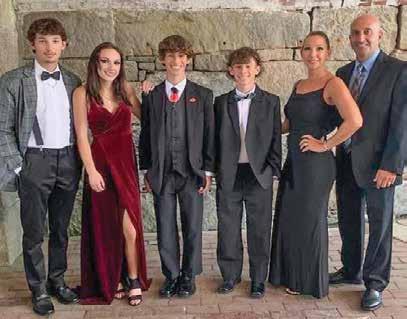

What happens to the people that are left behind? What happens to the survivors of suicide loss? That’s the gap that Betsy wanted to fill. She wants to bring some hope and light into people's lives who are trying to heal from such a traumatic loss and help them along their journey of healing.
So, she started the Cus Foundation. The Cus Foundation is a nonprofit organization that means Caring for Unexpected Survivors of suicide loss. Betsy wanted to build a foundation where she can provide services like meals, care packages and support groups. But she also wanted to offer a platform for people to go and access a multitude of resources, if they didn't want to contact her personally.
Some resources include:
• Links and information you need to know for when someone passes
• Support groups
• Restorative Yoga with Branches of Growth
• Links to getting meals
• Link to Hope For Bereaved, Inc.
• A list of therapists
“Either I can be involved in their journey by providing services, or they can access the website and get what they need,” Betsy explained.
When asked how people dealing with unexpected loss can find their coping mechanisms, she said everyone has their own tools that work for them.
“Don’t isolate yourself. You may want to, but don’t,” she said. She suggests finding the little things that give you peace, like taking a walk in nature or doing kickboxing to take out frustration.
As far as what others can do to help a loved one when experiencing grief, Betsy offered some helpful advice.
“People are so kind and tell you to let them know if you need anything,” she said. “But your loved one might be uncomfortable or not know what to ask for.”
Her advice? Don’t ask, just do. Things like doing favors, giving helpful gift cards, or offering to take them out somewhere could go a long way.
While Betsy is still learning, she leads by example by finding her little pieces of joy.
“My kids are the most important thing to me. I refuse to let them live a life of sadness and sorrow. I have to make it as beautiful and filled with love and laughter as much as I can,” she said. “That is my goal every day. Everyone should have a goal for the day, even if it is to take a shower.”
Something Betsy and her family look forward to once a month is what she calls “Back to Living,” where they do something together once a month.
Activities they’ve done are ax throwing, hiring a personal chef, and in July they are going to Disney.
In the future, she hopes the Cus Foundation will go nationwide. If you or anyone you know could benefit from the support the Cus Foundation provides, you can visit thecusfoundation.org.
“We're here only once with one chance to get it right,” she offered. “It's important to lead your life with love. I hope to heal while helping others to heal.” SWM








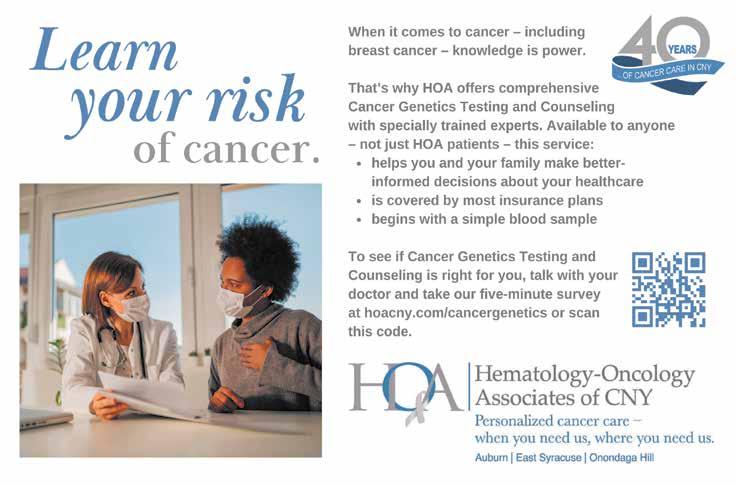
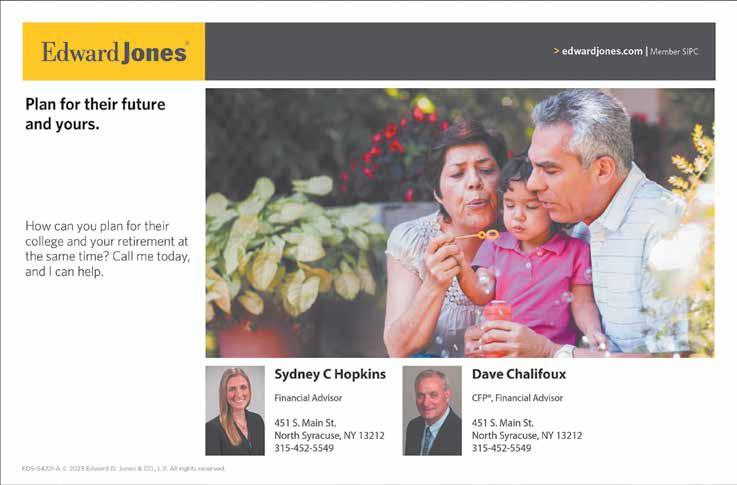

First and/or middle names can be familial or historical, reflecting one’s identity and place in the world. A given name can be deeply personal and help shape a child’s profound sense of self and belonging.
So imagine a young girl growing up perplexed that friends - even teachers - called her “Cindy,” while family members used her given name.
Today, make no mistake about it: “Cindy” is but a faint memory in the life of one of Syracuse’s most dedicated and accomplished champions. Named after her highly regarded father, she was raised and educated in the city she still calls home and to which she dedicates her life’s work.
‘She’ is Cydney Johnson, vice president of community engagement and government relations at Syracuse University. While she now chuckles about her childhood moniker, Cydney has grown proud over the years of not merely her name, but of both her namesake, father Sidney Johnson, a long-time educator and former superintendent of the Syracuse City School District (SCSD), and beloved mother, Vivienne Jean Johnson, for their leadership in supporting youth and families in the city.
Continued on page 24

Her parents served as role models for Cydney and her older sister, Melinda Jean. Sidney and Vivienne placed a high premium on service and education. Cydney’s father served in the military with the historic Tuskegee Airmen for more than two decades. He earned the rank of Major before retirement, an almost insurmountable challenge during the days of segregation, as well as a testament to his performance in service to our country.
A Syracuse University alum and historic figure for the Syracuse City School District, Sidney L. Johnson ’59, G’65, was recently added to the list of the University’s Notable Veteran Alumni. “Like most military families, we were not originally from the area. Syracuse adopted us, and both my parents loved serving this community,” says Cydney. Her father first served as the SCSD Superintendent and was subsequently elected to the Syracuse Common Council, followed by the Syracuse Board of Education. The family lived in Syracuse neighborhoods and the girls attended city schools, graduating from Nottingham High.
Cydney is right at home on the S.U. campus, having earned her undergraduate degree and MBA from the Martin J.
Whitman School of Management. She also spent seven years as an adjunct professor in the College of Human Development.

Reporting to Vice Chancellor J. Michael Haynie, Cydney joined Syracuse University as executive director for state and local government relations in the spring of 2018. She also leads the community engagement team as it helps to advance the university’s robust portfolio of community initiatives.
Cydney’s more than two decades of experience in government relations, higher education and nonprofit/business development serve her well in her role at S.U. and in the community. She is a member of the Central New York Regional Development and Planning board; a board member of the Syracuse Partnership Council with the Syracuse City School District; a board member of Syracuse Stage; and a board member of Blueprint15. Previously, she served on the boards of the Central NY Community Foundation and the Women’s Fund.
Syracuse University leadership is, according to Cydney, “a big believer in presenting the external face of the University to the community” in academic and non-academic ways. She says that Chancellor Kent Syverud, Vice Chancellor Haynie and many others in the S.U. community are committed to educating their neighbors by providing life-enriching yet sustainable programs.
This service component is what drew Cydney to her role at S.U. “What I am privileged to do every day at the University is an extension of my parents’ belief in providing meaningful situations, especially through education, to enhance lives.”
While her father was from down south - Summerville, Georgia,and her mother from up north, both had grown up with a “sensitivity to being denied material things and life experiences,” explains Cydney. “That’s why finding and creating opportunities for young people was so important to their mission in life - and why it’s rewarding for me now to carry on their purpose through the University’s programs for students in our area.”
The generosity of local organizations and individual donors make three summer programs available: Summer College, open to suburban high school students and SCSD students; the Internship Program for city high school students in the Career and Technical Education (CTE) program; and the Job Shadowing Program, for SCSD high schoolers enrolled at the Institute of Technology at Syracuse Central. Syracuse schools, university partnership
SCSD Superintendent Anthony Davis applauds the partnership between the city school district and the University. “We are truly grateful to the Syracuse University community for its steadfast support
of our SCSD students. Our students enjoy countless opportunities and experiences in partnership with the University that benefit them in so many ways,” he said. “These experiences help our students become more confident in their abilities and of the career paths they hope to pursue.”
As Cydney’s interactions with the Syracuse City School District have expanded, she often reflects on how fortunate she was to have Vivienne and Sidney Johnson as her parents. “I am so pleased to have the opportunity through Syracuse University to help make a difference in a young person’s life, the way my parents did for me,” she says. “The SCSD students are our future, and we owe it to them to offer mentorship and guidance.”
Cydney is proud of her father’s legacy in the Syracuse City schools. Named in his honor, the Sidney Johnson Vocational Center offers impactful non-traditional educational opportunities, such as adult workplace education and GED programs.
The well-known educator and administrator reflects on the bond she continues to share with her late father. Both are Syracuse University alumni at the undergraduate and graduate levels, and she carries on his educational mission in the Syracuse community. Cydney also bears his name - forgetting how long ago she was known as “Cindy.”
“In a global economy where the most valuable skill you can sell is your knowledge, a good education is no longer just a pathway to opportunity – it is a prerequisite.” — Barack Obama

Asked about her personal leadership style or philosophy, Cydney Johnson doesn’t invoke the latest so-called gurus or trends. Instead, she grows quiet and thoughtful. After some time, she names three women she admires: Candace Campbell Jackson, senior vice president and chief of staff to Chancellor Kent Syverud at Syracuse University; Anna Mae Williams, a community activist from Syracuse’s westside; and Kristina Johnson (no relation), former SUNY Chancellor.

Then Cydney begins to laugh and shares a story about her first job in retail at a large department store in Philadelphia, where she learned an important lesson about not judging others.
Her position was in Foundations (women’s undergarments), working for manager Eva McCoy. “I figured they’d assigned me there because I was new and hers was a sleeper department,” says Cydney.

The grandmother figure, Eva, was in fact, the store’s leading buyer with the consistently highest sales performance record. Not only was Eva an exceptional professional achiever, but she was also

compassionate. “She knew I was away from home at the holidays and allowed me to be off work to be with my family on the day after Thanksgiving, the busiest shopping day of the year,” Cydney recalls.
“When I protested, she insisted I be with my parents. I’ll never forget her kindness.”
Finally, with a soft voice and smile, Cydney added that she was most influenced by her mother. While she wouldn’t call them leadership skills in today’s terms, Cydney referred to her mom’s words and deeds as life lessons:
Practice humility, saying to yourself, “I’m not so special.”
Be respectful of all people.
Listen.
Practice gratitude: appreciate what you have.
Try to be patient: with yourself, with others, with situations.
Be persistent, but be nice while doing so.
Take time out to enjoy life through relationships and hobbies. Cydney enjoys gardening, feeling working with the soil and cultivating growth is very rewarding.
Keep learning.
Cydney’s mother took up learning to play the guitar when she was 82 and continued until she passed away at 90.
Cydney has followed in her footsteps, taking weekly lessons. She feels learning a new skill helps with creativity and patience.
Continued on page 26
Sidney and Vivienne Johnson Vivienne Johnson and Cydney JohnsonCydney Johnson from page 25
Three distinct programs offered during the summer at Syracuse University help provide professional mentorship and guidance to Syracuse City School District (SCSD) high school students in their chosen career possibilities.
“We appreciate that these summer experiences build a climate where our students feel they are part of the Syracuse University community — where they can see themselves in an institution of higher education, as well as in professional work environments,” said SCSD Superintendent Anthony Davis.
For 60 years, Syracuse University Summer College has provided students with a college-like experience while still being in high school. Students from an average of 35 U.S. states and Puerto Rico and 25 other countries take part in the summer on-campus and online options.
“We have 100+ credit and noncredit courses from 10 of the University’s schools and colleges,” says Chris Cofer, executive director of the Office of Pre-College Programs, which has expanded to include many options for pre-college students during the academic year. The most unique aspect of the program is the opportunity to live on campus in a residence hall while taking classes and enjoying cultural and social happenings.
While many students from private and suburban schools take advantage of Summer College, access for City of Syracuse district (SCSD) high schoolers has been prohibitive due to cost. “Vice Chancellor Michael Haynie and Bea Gonzalez, long-time dean of the College of Professional Studies (formerly known as University College), worked hard on pathways, yet funding to allow these students the experience remained nonexistent,” says Cydney Johnson.
In summer of 2020, the city schools committed funds, along with donations from private individuals
and organizations. Post-pandemic, Summer College returned to campus with an increasing number of SCSD students: 17 in year one, 31 in year two and 37 during 2023. “We are especially grateful to the International Brotherhood of Electrical Workers, IBEW Local 43 in Syracuse, for the $20,000 in funds they provided in 2023,” Cydney said. “This level of support will enrich students’ lives and provide workers for the jobs of tomorrow.”
In addition, the university provided partial need and merit-based scholarships to more than 150 students this summer, with more than 300 students attending Summer College at no cost to them or their parents though one of more than 30 partnerships.
The Summer Internship Program, launched three years ago, offers students attending any of the City of Syracuse’s five high schoolsCorcoran, Henninger, Nottingham, Fowler and the Institute of Technology at Syracuse Central - the chance to engage in an intensive experience with S.U. employees in a field that aligns with their chosen employment interests.
Internships began right after Independence Day for six weeks, four days a week. CNY Works employment center in Syracuse has provided funding so the interns could be paid. Fadumo Hassan, who interned in S.U.’s Food Services, said, “It was a really good experience and you get paid, which is a nice bonus,” adding that she would spread the word among other ITC students.
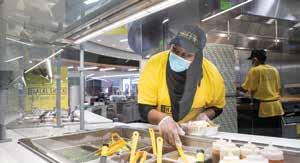
Enrollment in year one was 11 students, 19 in year two and 23 students this summer. “You can’t underestimate what it means to a young person to have an experience we’re able to provide at the University,” Cydney said. “For many of them, it’s life changing, and that’s our goal.”
Marie Malkoske likes to get her hands dirty tinkering around under the hood of a vehicle. As part of the
Job Shadowing Program offered by S.U. to SCSD students, she was able to do just that - not just for fun, but to make certain that a career in automotive technology was her true calling.


The Job Shadowing program, now in its second year, offers the opportunity for high school seniors enrolled in the SCSD’s career and technical education tract to gain valuable on-site experience observing professionals in their chosen field. The best perk, perhaps, is the certificate of completion a student receives at the end of the four-week period.“We want every student to dream big,” said Cydney,
who has been working to create opportunities for city of Syracuse students her entire career. She credits support from Vice Chancellor J. Michael Haynie and Chris Coffer for their support in turning her ideas into new programs.
“Not every kid wants to go to college, plus we need workers in the trades,” says Cydney. “We can use the vast educational resources of the University to create hands-on experiences where work-bound students learn from professionals. We want students to go into their careers with their eyes wide open to their futures.” SWM
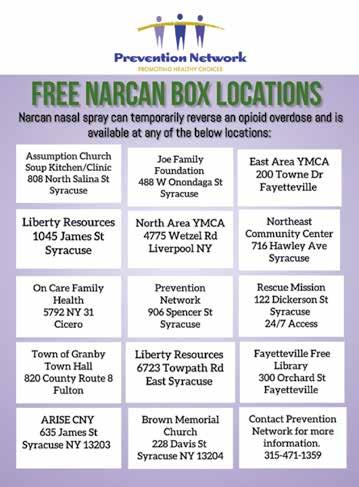
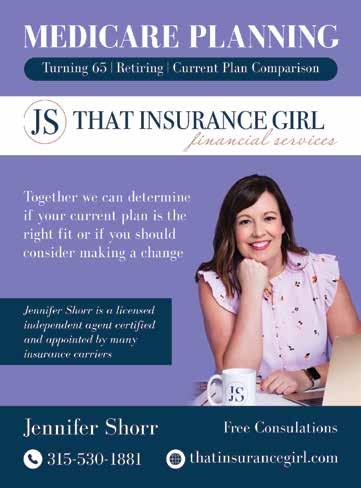

Are you a busy mom or a novice chef looking to up your culinary game and impress your family and friends? Cooking delicious meals doesn't always require hours of preparation or advanced skills. With a few simple ideas and smart strategies, you can enhance your culinary skills, expand your recipe repertoire, and become a confident home cook.
One thing I like to make sure of is that I have some essential staples for a well-stocked kitchen allowing me to be able to pull something nutritious and delicious in no time. I also like to have make-ahead freezer meals or partial components that will save the day when you're short on time.
4. Make or purchase pizza doughs.Press them out in individual portions and coat them generously with oil on both sides and grill them on both sides. Cool them and wrap tight and freeze. The uneven shapes and grill marks make for a gourmet looking base that can be topped and finished in the oven.

Stocking your pantry and fridge with essential staples ensures that you can whip up a delicious meal even on short notice. Here are some must-have items for a well-equipped kitchen:
1. Canned beans. Beans are versatile, nutritious, and can be used as a base for soups, stews, salads, or even veggie burgers. Keep a variety of
Preparing meals ahead of time and freezing them can be a lifesaver on busy days. Here are a couple of ideas for freezerfriendly meals:
1. Prepare lasagna noodles according to package instructions.
spread a mixture of ricotta cheese, cooked ground beef or turkey and tomato sauce
them in a baking dish. Cover with additional tomato sauce and sprinkle with cheese. Wrap tightly with foil and freeze. When ready to serve, bake at 375°F (190°C) for 30-35 minutes. (Do a Mexican version with taco meat, chilies, alfredo and cheese.)
2.
shredded chicken with diced green chilies, shredded cheese, and a little sour cream or cream cheese. Spoon the mixture into tortillas, roll them up, and place them in a baking dish. Pour enchilada sauce over the top, sprinkle with more cheese, cover with foil, and freeze. To serve, bake at 350°F (175°C) for 30 to 35 minutes.
3. Braise different meats like, pork, chicken, or beef and freeze them with a little juice/broth so they can be thawed quickly to use in tacos, wraps, in pasta dishes or atop a salad.
Becoming a skilled home cook doesn't have to be a daunting task. By embracing semi-homemade cooking, stocking your kitchen with essential staples, and preparing freezer-friendly meals, you can effortlessly enhance your culinary skills and amaze your loved ones with delicious meals. Remember, cooking is an art form that allows you to infuse your unique creativity and passion into every dish. So go ahead, experiment, and enjoy the wonderful journey of culinary exploration! SWM

4 cups shredded rotisserie chicken
8 oz cream cheese, at room temperature

¼ cup Buffalo-style hot sauce, plus more for serving
1 bunch scallions, thinly sliced, white and green parts separated
1 small can chopped green chilies
10 small corn tortillas (6 large)
2 cans of green enchilada sauce
2 Tbsp crumbled Mexican cheese or cheddar
Green onions, parsley or cilantro for garnish
Preheat the oven to 400 degrees F. Butter a 9-by-13-inch baking dish. Mix the chicken, cream cheese, 1 ½ cup of the Cheddar, hot sauce, green chilies, white parts of the scallions and cumin in a large bowl until
3. Fill tortillas evenly and roll placing seam side down in the pan.
4. Spoon a portion of the chicken mixture down the middle of each tortilla and roll up. Place them side by side, seam-side down, in the prepared pan. Pour the enchilada sauce over the tortillas. garnish with remaining Cheddar cheese.
5. Bake until the cheese is melted and bubbly, 15 to 17 minutes.
6. Garnish with Mexican cheese crumbles and sprinkle with the green herbs. Serve with salsa beans and rice.
Serves: 8-12 servings
INGREDIENTS
1 boneless pork sirloin roast (3 lbs)
5 cans (4 ounces each) chopped green chiles
2 Tbsp taco seasoning
3 tsp ground cumin
24 corn tortillas (6 inches), warmed
3 cups shredded lettuce or cabbage
1½ cups shredded cheese of your choice
1. Cut roast in half; place in a 3- or 4-qt. slow cooker. Mix chiles, taco seasoning and cumin; spoon over pork. Cook, covered, on low 8 to 10 hours or until meat is tender.
2. Remove pork; cool slightly. Skim fat from cooking juices. Shred meat with two forks. Return to slow cooker, heat through. Serve in tortillas with lettuce and cheese.
3. Get creative! Garnish with fresh limes, salsa, cilantro or radish slices, diced avocado or diced jalapenos.
Can you freeze Baja Pork Tacos? Place cooled pork mixture in freezer containers; freeze up to three months. To use, partially thaw in refrigerator overnight. Heat through in a covered saucepan, stirring gently and adding a little broth if necessary.
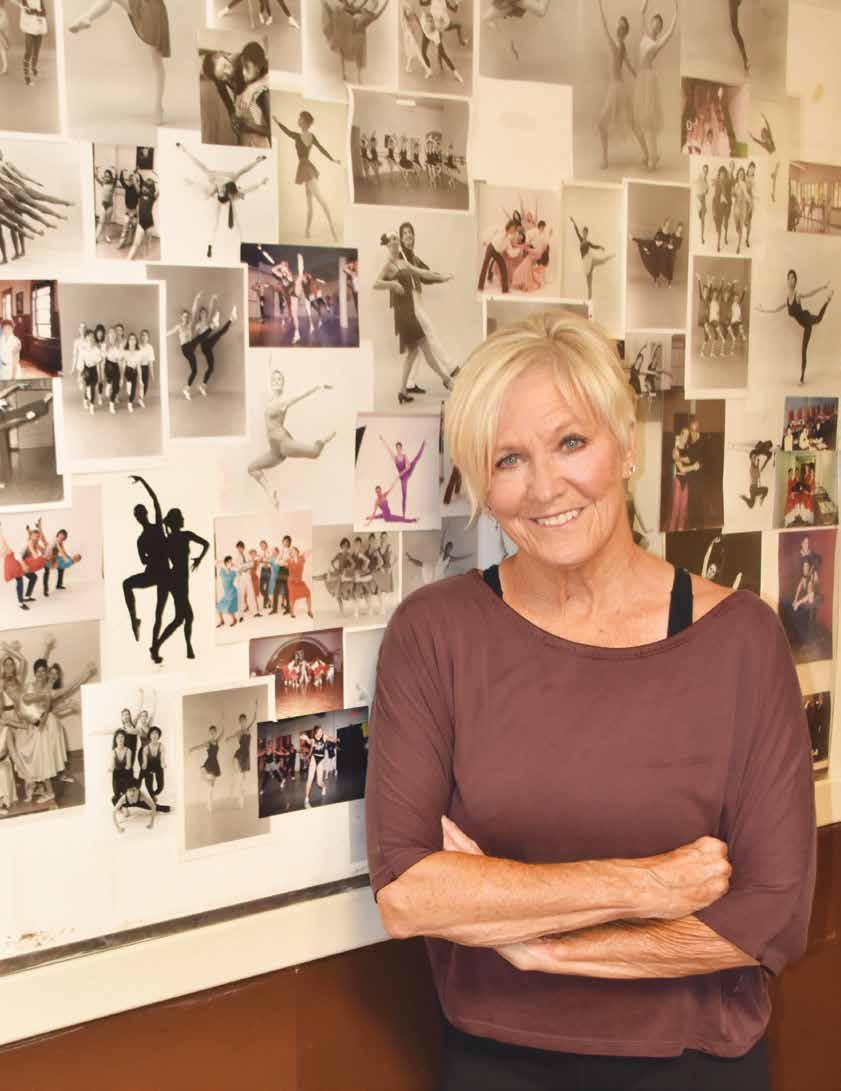

 Alyssa Dearborn
Alyssa Dearborn
After 40 years of owning the Syracuse School of Dance and acting as the artistic director of the Syracuse Contemporary Dance Company, Mary Pat Speno is retiring. Over the years, the school has expanded the different dance styles offered to students, but the school has remained dedicated to offering classes to all who want to learn how to dance. In her career, Mary Pat has helped thousands of students of all ages and levels of talent find artistic expression through dance, many of those students becoming life-long dancers themselves.
“I was a principal teacher for a woman, Lorain, 40 years ago and she was going to retire,” she said when asked about the school’s beginnings, “So she approached me, and at the time I had three little babies, and I said ‘Oh, Lorain, I can’t take on all this.’ And she said, ‘Well, get a partner!’ So a good friend of mine, Patricia Brandage, who also was a principal teacher at Lorain’s school, I approached her and she said, ‘Yeah!’ So the two of us bought the school from Lorain. Then Patti retired and I continued on and now it’s my turn.”
On the school’s website, it says that the school’s philosophy is “...that one can train a dancer, mind and body and that people thrive in a positive and nurturing environment.” Mary Pat emphasized that this philosophy applies to people of all ages, taking pride in the fact that no other dance school in the Syracuse area offers dance classes for adults.
“We cater to all ages and a really big part of our school is our adult division. There’s no other school in the city of Syracuse or surrounding areas that offers classes for adults,” she said. And yes, the emphasis for all those schools is the kids. And by the time they’re seniors in high school, they graduate and they’re gone, never to be seen again.”
Mary Pat said many of her students return during and after their college years and continue to progress in their dance, or come back later as a family with kids.
“So the adult aspect I’m very proud of is that we give these adults a chance, for whatever reason they wanted to dance,” she said. “For exercise, for relaxing, for stress relief, for performing. We have adults that have started in adult division classes, they end up performing with us in the Syracuse Contemporary Dance Company. So they get performing opportunities.
Mary Pat plans to sell the school to a fellow dance school owner and friend, Kathy Falcone of Ballet and Dance Center. The two schools have
shared teachers and other resources in the past, but most importantly, the two schools share similar philosophies.
“So Kathy wanted to expand and I wanted to retire,” she explained. “So this was the perfect opportunity to be able to have all the students continue on with this, because her philosophy’s the same as ours except they do not have an adult program. So she’s very excited about having an adult program.”
No matter the age group, she said, a good teacher displays concern and empathy for the challenges her students face, and watching the development of her students and how they overcome life’s difficulties has been one of the most rewarding aspects of her career.
“I think the feelings you get through the years, that you are totally aware of how much you’re helping these students. The little ones that some of them are afraid to walk in the door of the studio and they’re afraid at that age to be away from their parents. Then slowly they build confidence and slowly mold their bodies into these awesome little dancers,” she said.
“You have to be in tuned with all these different levels of live challenges, for all these different ages,” she continued. “But that in itself, the discipline of that, is what is totally helping them go through in a positive, nurturing way. And it’s helped me for sure as an adult having young kids and owning the studio and being in charge of the teachers that I hire…We’ve done it and we’re going to continue on.”
Although her years running a dance studio and directing a dance company have brought her joy, Mary Pat is looking forward to a little downtime.
“You know, owning a dance studio has been 24/7,” she explained. “Anyone who really owns a business, whether it’s a restaurant or whatever, you take it home with you. You’re always in front of your computer, or on the phone or if you’re not, you’re trying to relax and you’re thinking in the back of your head of such-and-such.”
Mary Pat said she and her husband plan to do a lot of camping and they also enjoy triathalons, which she will continue on in retirement. While she’ll miss the students and the classes, the less glamorous parts of the job – mopping floors and cleaning bathrooms – she’ll gladly leave behind.
“I’m going to leave everything open and see where things fall,” she said. “But no big plans, which excites me the most.” SWM
In the wake of the Supreme Court striking down President Joe Biden’s plan to discharge some or all federal student loan debt for tens of millions of Americans, as well as increasing costs of everyday essentials and climbing interest rates, it should be of little surprise that even thinking about personal finances makes over 50% of American adults anxious. What is surprising, however, is that even with the world’s knowledge at our disposal, over one in three Americans are not considered financially literate.
In fact, overall U.S. financial literacy rates have been slowly declining since 2020, dropping again this year to only 48% — the lowest it’s been since 2017 — while the number of adults with alarmingly low levels of financial literacy has been gradually rising, with 25% of American adults unable to answer even a quarter of basic financial literacy questions correctly. According to studies compiled by the U.S. Financial Literacy and Education Commission, only one-third of adults could answer at least four of five financial literacy questions on fundamental concepts such as mortgages, interest rates, inflation and risk.

Although Biden has announced a revamped effort to provide broad student loan relief, that plan could take months, at best, to be implemented. According to the Council for Economic Education, a flurry of new mandates and proposals have popped up across a dozen states, including Florida, Kentucky and Rhode Island, and for the first time, 50% of states require economics for graduation.
Financial literacy is a necessary tool in all of our tool belts. Being financially literate can mean a heightened awareness of financial fraud and scams, improved money management skills, increased confidence in financial decision making, and can promote an overall happier life. With smartphones millions of times more powerful than the guidance computer NASA used for the famous Apollo 11 mission readily available, it is even easier to educate ourselves on financial literacy with the myriad of resources online, and yet, the national rate continues to fall.
In the face of our challenging economic climate, we must harness the tools within our grasp to make healthier financial decisions and give ourselves a greater chance of achieving financial freedom, mobility and security.
According to a report from the National Financial Educators Council, individuals participating in a survey said their lack of financial literacy cost them anywhere from $0-$10,000. That lack of knowledge can affect everything from how much you save on a regular basis versus emergencies, to how much debt you take on. Time and time again we see too many people fall victim to the cyclical trap of poverty, many times for reasons out of the individual’s control, and while we can wait for our federal, state or municipal governments to implement comprehensive financial literacy programs, we can also jumpstart our financial health by using the tools available to us.
These tools, including apps like Zogo which gamify learning, EconEdLink which offers hundreds of free personal finance and economics lesson plans, videos, activities, tools, and more for K-12 teachers, students and their families, combined with the dozens of financial podcasts and personal finance books can alleviate some of the burdens of financial anxiety and provide a more hopeful outlook. As of 2020, 42% of adults worry about meeting their daily expenses, and that number will continue to rise until we encourage and prioritize gaining financial literacy.
With a device in our pockets that knows everything about anything, we have an advantage that previous generations did not. We shouldn’t have to worry about whether our next breakfast will impact our future ability to buy a home — learning to effectively save elsewhere can evade that. However, until we establish proper infrastructure to support financial literacy efforts, we must accept the onus and lead ourselves towards a happier, more secure future. SWM






f you’re looking for a resource for anything from the runway to rhetorical theory, Caprice Hibbler is Syracuse’s go-to guru.

After graduating from Onondaga Community College with an associate’s degree this past May, Hibbler is continuing her education at Syracuse University, as well as pursuing a passion project of her own— The Caprice Show.



Though the show will be her namesake, The Caprice Show is far from Hibbler’s sole pursuit. Hibbler has served as an Administrative Assistant at Upstate for over a decade, and works as the coordinator for The Arts Project Syracuse [TAPS] through CNY Arts as well. The Caprice Show, like Hibbler herself, will be dynamic, community-oriented and expansive in many directions.
“I want the show to be more so about our daily lives,”
“We do have a lot of shows out there, but what I want to stick out more is giving these people - people like mea platform to speak and [give] back to the community.”
To accomplish this, Hibbler plans to travel and interview different people “in their comfort zones” when the show starts filming in August. In addition, Hibbler plans to discuss fashion, lifestyle, design and anything else under the sun - except for politics.
“That’s the only stipulation on the show - let’s just stay away from politics, ‘cause we’ve got too much of that going on,”
Beyond that, she said the show will have “endless opportunities. I just want it to be a safe place, and fun you know, and something that I can give back to the community.”
Hibbler emphasized that she wants this space to be especially welcoming to younger audiences.
“I feel like the younger folks now are so lost with everything going on in the world, you know, with social media,” she said. “If I can touch the
younger folks, and be an inspiration to them to want to give back to the community and want to do good…maybe the world would be a little better.”
Hibbler drew connections from the youth of her audiences to her own youth, as well.
“Growing up, you know, we didn’t have the resources,” Hibbler said. “I had…to go out and do everything myself because I didn’t have a handout. I didn’t have that help. So I always had to work for what I wanted.”
This is not the only way Hibbler’s childhood has impacted her present-day goals. Community values are ever strong in Hibbler’s life and work, from her background to the key components of her upcoming show.
“Growing up, we moved from house to house so I lived…in all different communities,” Hibbler said.
“I know people from literally every side of town, all walks of life…I lost a lot of friends and family to violence in the streets. And I just really want to be an ally where I can try and see…what can we do to stop the violence on the streets? What can we do to make the streets a little safer?”
Hibbler continued, “I just want to just really just be an ally and see if I can just make the community a little better with giving back and being there and being an ally.”
Though her values lie in the world around her, Hibbler’s success originates, too, from her sure sense of self and her future. Hibbler summed it up perfectly, expressing, “What may be for somebody else is not for me; and what’s for me, it’s not for no one else.”
For more on Hibbler’s all-encompassing passions, values and horizons, make sure to keep an eye out for The Caprice Show, where we’ll see what’s “for” Caprice in Hibbler’s perfect vision SWM












Allison Hunt has always had a passion for experiencing different cultures and languages. In 11th grade she studied abroad in France for a year as part of the Rotary Youth Exchange and truly enjoyed getting out of her comfort zone. The experience sparked her love of learning about different cultures and languages.
Allison, who is from Baldwinsville, was inspired to study abroad again in China, which happened to be virtual because of the pandemic. She enjoyed learning about the differences between Chinese culture from her own.
“It was really cool to learn about the different philosophers and how the [Chinese] government works, and how the beliefs and ideologies work there versus here,” she said. Allison believes it’s important to take the time to understand the different cultures and different aspects of society that we see as “normal,” so we can approach solutions with more of an open mind.
Allison will be entering her junior year at Minerva University where she studies political science and government. Based in San Francisco Minerva has a global rotation, so students from more than 60 different countries study abroad in a different location each semester. So far, she has studied in Seoul, South Korea, Taipei, Taiwan, and Hyderabad, India. In the fall, she will study in Buenos Aires, Argentina.
Fluent in both French and Chinese, she is now working on learning additional languages and is the president of Minerva University’s Language Club, a student initiative called Langs.
Known for its global, immersive, and purposeful approach to higher education, Minerva was named the most innovative university in the world for the second consecutive year, according to World's Universities with Real Impact (WURI).
“The way Minerva approaches education is a lot different than other universities. All of our classes are online and based on the science of learning,” she said. “The focus is on the study of how people learn best. All of our classes are discussion based. We gain a lot of value from the lectures, discussions, taking notes, and asking questions rather than information crammed by professors. They want to equip us with tools that will be useful for our future.”
Last year Allison was accepted as a delegate at a pair of international summits scheduled for this summer: the China-America Student Conference
Allison recently wrapped up the China-America Conference and couldn’t say enough about her positive experience.
“We had a very diverse pool of students. For example there was a student from Hong Kong, we had a Malaysian-Chinese student who grew up in the U.S, we had students from the U.S. whose parents are from Taiwan, so it was really cool to get such differing opinions on international relations,” she said. “There was a very wide range of perspectives. And me, having lived in Taiwan as a foreigner, the conversations were very enlightening.”
The CHASC focused on all aspects of the U.S. and China relations. Allison and the other students met with the Asia group, a business advisory firm headquartered in Washington, D.C. They also met the chief economist of Bloomberg economics to learn about international companies and governments that use their software.
Allison engaged with The China Project to learn more about the role of journalism in U.S. and China relations. “We talked about how certain words that we use in stories and headlines affect people’s view of the U.S.-China Relations and international relations in general,” she explained.

They visited the Utah Chinese Dual Language Immersion Program where they learned how students from a very young age have been learning Chinese. “I think we need more of that. Some of the funding for Chinese programs have been cut due to the state of the relations. But we need more language learning to enhance cultural understanding. It would help to decrease the language and cultural barrier between us,” she said.
In addition to making lifelong friends through the CHASC, Allison has been elected as American chair for the next year’s conference.
“I had a really great time at the conference. I learned a lot and it was really impactful,” she said. “I can’t wait to help start planning next year’s conference and give others this great opportunity.”
Allison is currently experiencing the Korea-America Student Conference. Having already studied in Korea and understanding the Korean education system, and the problems facing North Korean Defectors, she was very excited for this experience.
These conferences, she said, are important because they are combining young leaders from different countries with different cultures and languages.
As for Hunt’s future plans, already having spent a semester in Korea, she plans to return someday after graduation. She is interested in discussing education at the KASC and emphasizes her belief that different countries should try to understand each other and our different systems.
“I think that is what's cool about these conferences. I'm becoming so much more aware of different career paths and what is important for international relations. It's a really good professional experience talking to different people in the field,” she shared. “I hope to be a leader and promote cross-cultural dialogue so that we can come from a point of understanding with each other to foster tangible change. Youth is the future, and I will work tirelessly to bring the world closer and fight for the rights of everyone, everywhere.” SWM







Ellyn Riley has been investigating tough questions her whole lifesome about the intersections of science, people, and family, some about her career and what it means to be a woman in the sciences. While the answers weren’t always easy to find, they led her to who she is today, an associate professor of Communication Sciences and Disorders (CSD) at Syracuse University and the founding director of a lab investigating aphasia, a lesser-known language disorder in which people struggle with word finding and comprehension. Throughout her journey, she has dedicated her life to communication and human connection, and it's that kind of dedication that we can all learn from and be inspired by.
The Catalyst
“[My dad] was a professor and a research scientist when I was growing up. So that was an influence for my interest in science,” Riley said. “One of the things he encouraged me to do was science fair, which was at first not something [I] really wanted to do . . . but it was something that I was actually pretty good at and so I kept going with it.”
But during high school, as Riley won scholarships and awards at international science fair competitions, her grandmother had a stroke. This “funny and heart-warming” newspaper columnist suddenly lost her ability to do her job. While her intellect remained intact, “she was really not able to express herself through speech and writing the same way after the stroke,” Riley said. “I knew as a kid living far away that she really couldn’t talk on the phone very well like she used to be able to. We used to call her up every week and talk to her. And that was sort of my understanding of [aphasia] then.”
That was the new normal as Riley attended University of New Mexico in Albuquerque, majoring in biology in the hopes of doing some kind of science research. “I started working in a few different more wet-lab kind of science labs, working with cancer cells, but I thought I was going to like it more than I ended up liking it. I realized that the thing missing for me was that there was very little interaction with people, and so a lot of the things we were doing seemed to me so far from who we were trying to help.”
It wasn’t until she took a linguistics class that she learned about aphasia. “I realized, ‘Oh, that’s what my grandmother has.’ I made that connection, so that made it very personally interesting for me. I started doing some research on my own, [asking] what is aphasia? I realized there’s this whole field out there, speech pathology, that studies neurogenic communication disorders, and this is something that I didn’t even have an awareness of before college.” At this time, her grandmother still had trouble talking, reading, and writing, but she was getting better, and Riley wanted to know more. So she minored in Speech and Hearing, and eventually enrolled in a doctoral program at Northwestern University conducting research in CSD.
The more she learned, the more she connected with her grandmother. “[I] would go visit her every couple of months so sometimes I would bring language tests with me so I could practice them, and she was always really nice about participating in that and just sort of encouraging my interests in it.” Her grandmother’s aphasia was barely perceptible at that point. “Some people make a really great recovery, and I think my grandmother is
a good example of that, and other people have a hard time and might for the rest of their lives have significant language difficulties. It really depends.”
Although her primary focus was research, she decided to also complete a clinical degree in speech-language pathology, making her a better researcher because she could more effectively communicate with patients about their needs, which led her to new questions: “What kinds of research questions should we be asking? Not just what I want to know, but what do they need? So how can we shape our research to fit the needs of the population?”
In 2014, Riley brought her questions about aphasia to Syracuse University and started the Aphasia Lab. She received grant funding from the National Institute of Health to determine if electrical brain stimulation can enhance the effects of behavioral therapy for people with the disorder. She’s also among the first to examine the ways significant fatigue effects people with aphasia and strokes; and now, with the help of a grant from the National Aphasia Association and the Academy of Aphasia, she’s developing assessment tools and training for providers.
For the former study, they’re still recruiting participants. For the latter, they’re still recruiting participants as well, and she’s finally gaining respect for her ideas. “[Fatigue research is] something I’ve been interested in from the very beginning when I started in academia, but it’s been really hard to get going because it hasn’t been fundable research up until now. It’s not until [it became] sort of a hot topic where now it’s starting to get on people’s radar…I think that the tide, I hope, is going to be turning toward focusing more on experiences of the patients and exploring some of those areas.”
Hopefully another tide will be turning too: sexism and gender bias in the sciences. “[The speech-language pathology and audiology] field is predominantly female, over 95 percent of us identify as female . . . but [recent research showed] there is still a gender discrepancy in that historically, higher proportions of prestigious career awards have gone to males, who are also more likely to receive higher starting salaries, so gender bias is still there.” Although individuals with a wide range of gender identities have contributed to Riley’s research over the years, 100 percent of those currently working in Riley’s lab are female, and she’s made it a point to create a research setting that fosters free expression and the importance of trial and error in science. “I try to have a pretty open-discussion kind of environment, encouraging brainstorming, encouraging ideas.”
With all the progress she’s made, Riley’s certain that her future will be filled with more questions. “[Research] is not just about answering the question that you originally presented. . . but also being open to new questions that will come up, other things that you notice about the participants . . . that make you think about another interesting question, which could end up taking your research in an entirely different direction.”
For more information about the Aphasia Lab, visit https://aphasialab.syr.edu.
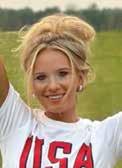
Born and raised in CNY, 26 year old Emilya Washeleski has been crowned Miss Multiverse America. Emilya is a multi-faceted ambassador for healthy living, holistic wellness and empowering women. She is also a 17X World & Reserve Champion Equestrian, published author, industrious entrepreneur, actress and beauty queen.
The world finals of Miss Multiverse 2023 (11th edition), being held this October/ November at o.a. Hard Rock Hotel & Casino Punta Cana is bringing together 30 extraordinary and empowered women from 30 countries. This contest is not based on looks, it's instead based on character, skills and capabilities. The TV Reality show “I am Multiverse” will follow these ladies through their journey of challenges.

Brooke Windey, RN, BSN, of Mexico, started at Oswego Health in 2000 as a nurse aide in the medical surgical unit at Oswego Hospital. For the past 23 years has held various positions as an RN-BSN, including clinical trainer for the healthcare system, before understanding her passion was in Information Services & Technology when she was asked to advise on the adoption of a new clinical technology that would assist with patient care. In 2011 Windey transitioned to the IS&T department as an IS&T clinical analyst II. In 2013 she was promoted to clinical analyst III and now has earned the title of clinical analyst III manager.
Jennifer Bacon of Oswego, started in the healthcare system in 2005 originally in the pharmacy department at Oswego Hospital as a technician. In 2011 she too was tasked with assisting the IS&T department with a new clinical platform and quickly realized how both careers could overlap. She was then promoted to pharmacy IT technician before transitioning fully to the department in 2013 as an IS&T clinical analyst II, then a clinical analyst III in 2017, before earning her new title as clinical analyst III manager.
“It gives me immense pleasure to announce the promotion of Brooke and Jennifer to Managers in our Applications Department,” said Barry Ryle, VP of information systems and chief infor-mation officer. “They have both been an integral part of the IS&T Clinical Applications Team for more than a decade and have been instrumental in building and deploying the applications that we have today.”
Linda Gabor, CPE, CFE, Partner has been appointed to the board of trustees by the Health Foundation for Western & Central New York. The Health Foundation for Western & Central New York is an independent private foundation that advocates for continuous improvement in health and health care for the people and communities of Western and Central New York.
Linda has been with Grossman St. Amour CPAs since June 2007. She is a certified public accountant in the State of New York and a certified fraud examiner. She leads the firm’s audit practice, employee benefits plan practice, and peer review practice. She is the current chair of the Pennsylvania Institute of Certified Public Accountants Peer Review Committee. Linda's other community service commitments include advisory board member of Maureen's Hope Foundation, and membership to 100 Women Who Care CNY. She is a graduate of Le Moyne College with a BS in accounting and economics. She lives in Clay.
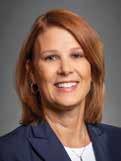
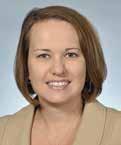
Solvay Bank is pleased to announce the recent new hires: Renee Dellas, Sarah Kirst, and Katherine O’Neill.
Renee Dellas recently joined Solvay Bank as the vice president and commercial banking manager. She brings over 34 years of financial services experience and lending leadership to the bank. She received her bachelor's degree from Cornell University and a master’s degree in business administration from the State University of New York at Oswego. Renee is an active member of the Financial Women’s Association and Cornell Alumni Association.
Sarah Kirst joined Solvay Bank as a mobile banking associate. Prior to joining the bank, Sarah worked as a substitute teacher for the Syracuse City School District. She is a graduate of Keuka College with a bachelor’s degree in business administration and management.


Katherine O'Neill joined the business strategy team as a project and marketing campaign manager. She brings over seven years of marketing and project management skills to the team. Kat is a graduate of Coastal Carolina University with a bachelor’s degree in marketing and is an active volunteer cheer coach at West Genesee Pop Warner.


Tuesdays in August
Downtown Farmers Market

What: Throughout the growing season, the market features local farmers and produce dealers each week, selling fresh, seasonal vegetables, fruits, baked goods, flowers, plants, and more. Each week, the market features a "Lunchtime Live Music Series" (11:30 a.m. to 1:30 p.m.) performance presented by CNY Arts, Onondaga County and SUNY Oswego.
Where: Clinton Square
161 Genesee St, Syracuse, NY 13202
When: Beginning at 8 a.m.
Wednesdays in August
Wine & Whiskey Wednesdays
What: Enjoy wine and whiskey tastings and live music with friends.
Where: Epicuse

334 S Salina St, Syracuse, NY 13202


When: 5 p.m. to 9 p.m.
Saturdays in August
Yoga in the Park
What: Vyana Yoga in Manlius is once again offering "Yoga in the Park", free of charge, at Clark Reservation State Park. This year there is a session every Saturday morning at 8 a.m. starting June 3; last date of the season is Saturday, August 26. Meet at the flagpole on the lawn in front of the Nature Center.
Where: Clark Reservation State Park
6105 E Seneca Turnpike, Jamesville, NY 13078
When 8 a.m. to 9 a.m.
Friday, August 4-Sunday, August 13
West Side Story
What: Presented by Syracuse Shakespeare in the Park, star-crossed lovers meet at a dance in the late 1950s and fall in love instantly.

Where: Thornden Park
Thornden Park Dr, Syracuse, NY 13210
When: Friday and Saturday: 5:30 p.m. Sunday: 2 p.m.
Info: Donation, different ticket levels. Visit www.ssitp.org.
Wednesday, August 9 through Tuesday, August 29, except Sundays
Beautiful: The Carole King Musical
What: Beautiful tells the true story of Carole King’s meteoric rise to fame as one of the twentieth century’s foremost singer-songwriters.
Where: Merry-Go-Round Playhouse
6877 E Lake Rd, Auburn, NY 13021
Info: Box Office: (315) 255-1785
Saturday, August 12
CNY Highland Games
What: Join for a day of competitions, children’s games, entertainment, Celtic-themed vendors, food and more.

Where: Long Branch Park
3813 Long Branch Rd, Liverpool, NY 13090
When: 9 a.m. to 8 p.m.
Saturday, August 12
Lightning Moon Pop-up Shop
What: Shop from 20+ vendors selling art, jewelry, tarot, candles, food, drinks and more.
The Buried Acorn Taproom

East Fayette St., Syracuse
6 p.m. to 9:30 p.m.
Through August
Skaneateles Festival
A dynamic four-week music festival providing intimate access to the world’s best music in the heart of the Finger Lakes Region.
Skaneateles
Visit www.skanfest.org.

Saturday, August 19
Free Community Day
What: Will feature intergenerational performances, interactive installations, and art activities that explore indigenous cultures.
Where: Everson Museum of Art

401 Harrison St, Syracuse, NY 13202
When: 11 a.m. to 4 p.m.
August 25
Karts 4 Kids

What: Join for a golf tournament to benefit the McMahon Ryan Child Advocacy Center.
Where: Drumlins
800 Nottingham Rd., Syracuse
When: 8 a.m. to 5 p.m.
Info: www.mcmahonryan.org.

